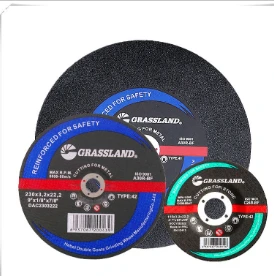The Price of Grinding Wheels An Essential Consideration for Manufacturers
Grinding wheels are indispensable tools in various manufacturing processes, playing a crucial role in shaping, finishing, and machining materials
. As industries continue to evolve and demands for precision increase, understanding the price of grinding wheels becomes essential for manufacturers who want to maintain quality and efficiency.Factors Influencing the Price of Grinding Wheels
1. Material Composition One of the primary determinants of the price of a grinding wheel is its material composition. Grinding wheels can be made from various materials such as aluminum oxide, silicon carbide, cubic boron nitride (CBN), and diamond. Each type serves specific applications and has different costs associated with it. For instance, diamond grinding wheels are often more expensive due to their superior cutting capabilities and longevity.
2. Wheel Size and Specifications The dimensions and specifications of the grinding wheel also significantly influence its price. Larger wheels or those with specialized features (such as varying grit sizes or shapes) tend to be more expensive. Manufacturers must carefully consider the required specifications based on their machining needs to avoid unnecessary expenditure.
3. Brand and Quality The brand reputation and quality of the grinding wheel can greatly affect its price. Established brands with a proven track record tend to command higher prices due to their reliability and performance. While purchasing cheaper alternatives may seem appealing, it is essential to consider the potential costs of lower quality, such as increased wear and tear on machinery or the need for frequent replacements.
4. Production Volume and Customization For manufacturers requiring a large quantity of grinding wheels, bulk purchasing can lead to significant cost savings. Customization can also influence price; specialized grinding wheels tailored for specific applications may come at a premium. Assessing the balance between customization and cost-efficiency is vital for manufacturers aiming to optimize their operations.
price of grinding wheel

5. Market Trends Global supply chain dynamics and market demands can also impact the pricing of grinding wheels. Fluctuations in raw material costs, trade policies, and economic conditions can lead to price variations. Staying informed about market trends can help manufacturers anticipate changes in pricing and plan their procurement strategies accordingly.
Long-Term Value versus Initial Cost
While it may be tempting to opt for the cheapest grinding wheel available, manufacturers should consider the long-term value of their investment. A higher-priced grinding wheel made from superior materials may last longer, require less frequent replacements, and provide better performance, ultimately leading to cost savings over time.
Additionally, using high-quality grinding wheels can improve machining processes, resulting in better product quality, reduced waste, and increased worker safety. These factors contribute to a more efficient production line and can enhance a company’s reputation in the marketplace.
Conclusion
In summary, understanding the price and value of grinding wheels is essential for manufacturers committed to quality and efficiency. By considering the various factors that influence pricing—such as material composition, wheel specifications, brand reliability, and market trends—manufacturers can make informed purchasing decisions. Ultimately, focusing on the long-term benefits of high-quality grinding wheels can lead to greater operational success and improved profitability. Investing wisely in grinding wheels not only enhances production capabilities but also supports sustainable business practices in the competitive manufacturing landscape.
Post time:Dec - 11 - 2024

















